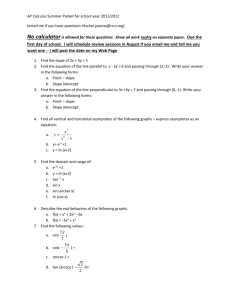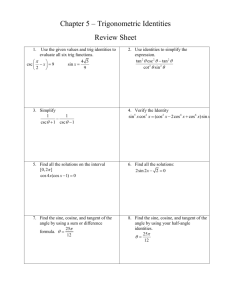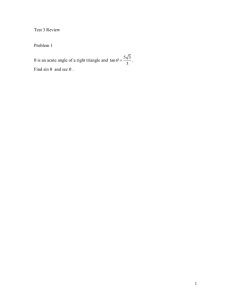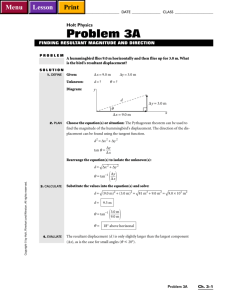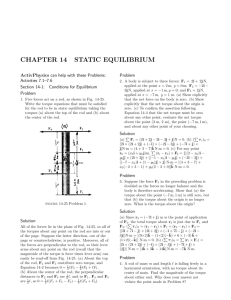MATH 1720 – Precalculus – Final Exam, Fall, 2002
advertisement
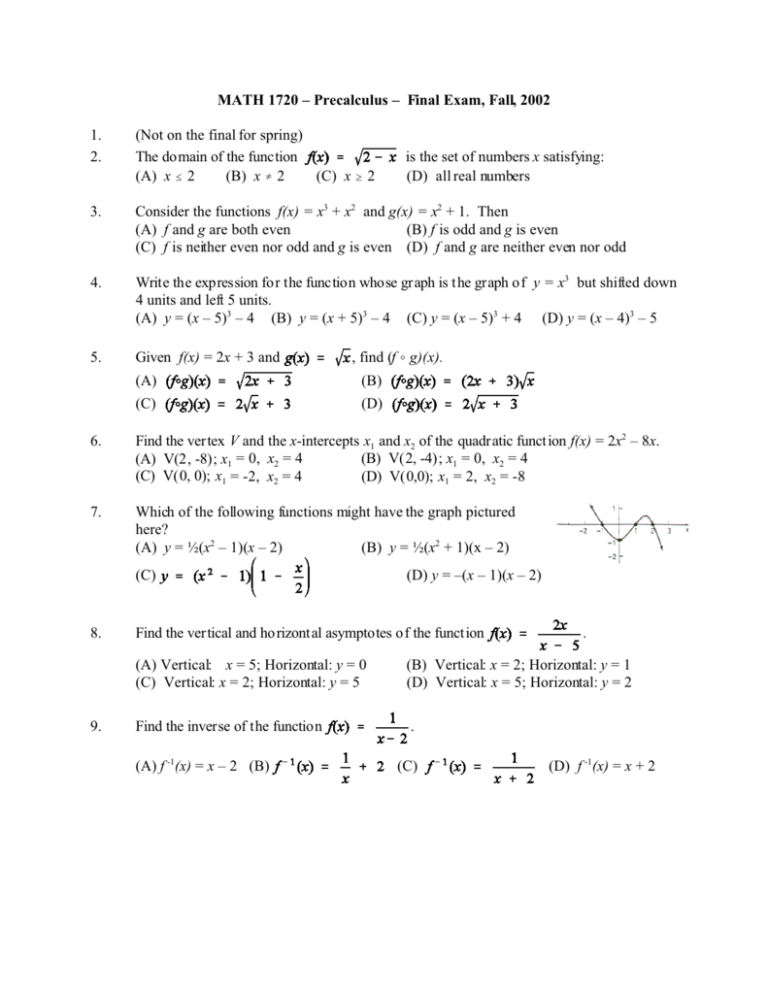
MATH 1720 – Precalculus – Final Exam, Fall, 2002
1.
2.
(Not on the final for spring)
The domain of the function
(A) x # 2
(B) x
2
(C) x $ 2
3.
Consider the functions f(x) = x3 + x2 and g(x) = x2 + 1. Then
(A) f and g are both even
(B) f is odd and g is even
(C) f is neither even nor odd and g is even (D) f and g are neither even nor odd
4.
Write the expression for the function whose graph is t he graph of y = x3 but shifted down
4 units and left 5 units.
(A) y = (x – 5)3 – 4 (B) y = (x + 5)3 – 4 (C) y = (x – 5)3 + 4 (D) y = (x – 4)3 – 5
5.
Given f(x) = 2x + 3 and
is the set of numbers x satisfying:
(D) all real numbers
, find (f B g)(x).
(A)
(B)
(C)
(D)
6.
Find the vertex V and the x-intercepts x1 and x2 of the quadratic funct ion f(x) = 2x2 – 8x.
(B) V(2, -4); x1 = 0, x2 = 4
(A) V(2, -8); x1 = 0, x2 = 4
(C) V(0, 0); x1 = -2, x2 = 4
(D) V(0,0); x1 = 2, x2 = -8
7.
Which of the following functions might have the graph pictured
here?
(A) y = ½(x2 – 1)(x – 2)
(B) y = ½(x2 + 1)(x – 2)
(C)
8.
9.
(D) y = –(x – 1)(x – 2)
Find the vertical and horizontal asymptotes of the function
.
(A) Vertical: x = 5; Horizontal: y = 0
(C) Vertical: x = 2; Horizontal: y = 5
(B) Vertical: x = 2; Horizontal: y = 1
(D) Vertical: x = 5; Horizontal: y = 2
Find the inverse of the function
.
(A) f -1(x) = x – 2 (B)
(C)
(D) f -1(x) = x + 2
10.
A
Which of the following is the graph of the function f(x) = -3-x ?
B
C
11.
Give the domain D, range R, and the x-intercept X of the function y = lin x.
(A) D = {x | x > 0}; R = all real numbers; X = 1
(B) D = all real numbers; R = {y | y > 0}; X = 1
(C) D = {x|x > 0}; R ={y | y > 0}; X = 1
(D) D = all real number; R = all real numbers; X = 0
12.
Solve the equation: log4 x + log4 (x – 3) = 1.
(A) x = 4 or x = 1
(B) x = 3.5
(C) x = 4
D
(D) no solution
13.
Iodine 131 is a radioactive material that decays according to the funct ion A(t) = A0e-0.087t,
where A0 is the initial amount present and A is the amount present at time t (in years).
Determine how long it takes for 250 grams of iodine 131 to decay to 50 grams.
(A) 19 years (B) 5 years
(C) 50 years (D) 10 years
14.
Find the length of the arc of a circle with radius 10 cm subtended by a central angle of 45/.
(A) 450 cm
(B)
cm
and tan
: (A)
(C)
cm
cm
15.
Find sin
16.
Suppose that cos 2 = 3/5 and 2 lies in Quadrant IV. Find sin 2 and tan 2.
(A) sin 2 = 4/5, tan 2 = -4/3
(B) sin 2 = -4/5, tan 2 = -4/3
(C) sin 2 = 4/5, tan 2 = 4/3
(C) sin 2 = -4/5, tan 2 = 4/3
17.
Determine the equation of the sine function which has amplitude 2 and period 4.
(A) y = 2 sin (4x)
18.
(B)
(B)
(D)
(C)
(C) y = 4 sin (2x)
(D)
(D)
For what values of x between 0 and 2B does y = sec x have vertical asymptotes?
(A)
(B)
(C) 0, B, 2B (D) There are no vertical asymptotes.
19.
Find the exact value of tan-1(-1) and cos-1(-1).
(A)
20.
(B)
Which of the following equals
(A) cos 2
21.
22.
24.
(C) 1 – sin 2
If
and 2 lies in Quadrant II, find the exact value of
(A)
(B)
(C)
(D) 1 + sin 2
.
(D)
If
(B)
(C)
(D)
What are the first four positive solutions of the equation
(A)
(B)
(C)
(D)
?
Find all solutions in the interval [0, 2B] for the equation 2 cos2 2 – 1 = 0.
(A)
25.
(D)
?
(B) – cos 2
(A)
23.
(C)
(B)
(C)
(D)
A ship, off-shore from a vertical cliff known to be 200 feet high, takes a sighting of the top
of a cliff. If the angle of elevation is found to be 15 degrees, approximately how far offshore is the ship?
(A) 3000 feet
(B) 1500 feet
(C) 500 feet
(D) 750 feet
Answers
1. D
8. D
15. A
22. D
2. A
9. B
16. B
23. B
3. C
10. D
17. B
24. C
4. B
11. A
18. A
25. D
5. C
12. C
19. D
6. A
13. A
20. B
7. C
14. D
21. C


